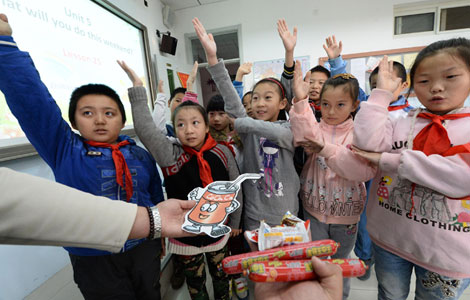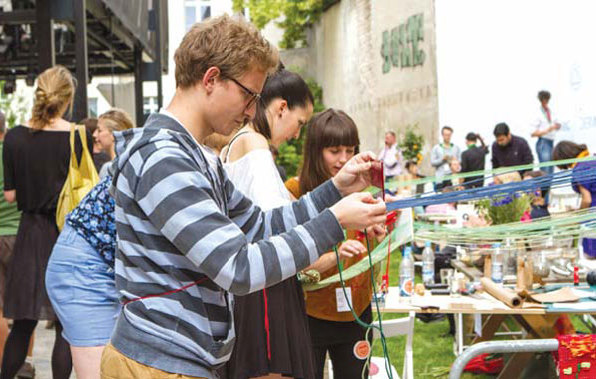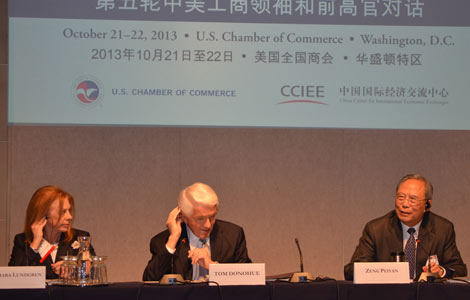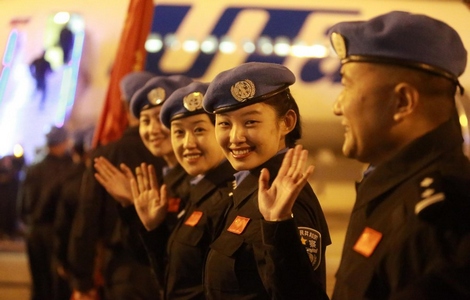Traveling lab takes on challenges of urban life
Updated: 2013-10-24 07:35
By Han Bingbin (China Daily)
|
||||||||
To identify some of the most urgent and controversial challenges for cities today and their possible solutions, the BMW Guggenheim Lab, defined as an urban think tank and co-initiated by the Solomon R. Guggenheim Foundation and the BMW Group, has spent the past two years traveling from New York to Berlin and Mumbai, to inspire innovative reflections on urban life.
The lab launched in New York with a focus on "confronting comfort", then traveled to Berlin with the theme of "making" that emphasizes public participation in building cities, and finally opened in Mumbai where projects explored the topic of "privacy".
With mobile structures designed by Japanese architects, including a novel carbon-fiber house built in New York and Berlin and a set of bamboo structures installed at multiple locations in Mumbai, the labs have served as community centers of another kind.
They've attracted tens of thousands of participants from more than 160 countries to engage both on-site and online in the lab's nearly 600 interactive public programs, often in the form of workshops, film screenings and research projects, where participating architects, academics and artists are ready to share their expertise.
|
People join in the Participatory City project launched by the BMW Guggenheim Lab in Berlin. Provided to China Daily |
The ongoing exhibition Participatory City: 100 Urban Trends from the BMW Guggenheim Lab, sums up these experiences with 100 of the most discussed concepts at the lab. Projections of these trends alongside drawings, videos, and other visual representations are displayed on the Guggenheim gallery walls in an all-digital installation.
In addition, interested architects, academics and artists from outside those three cities have created digital responses to the 100 Urban Trends, including one from Hong Kong that particularly responds to Rural Migration, the phenomenon of rural villagers moving to urban areas for work.
"We have extended our mission beyond the walls of the museum, providing the Guggenheim with new ways to engage directly with the public and demonstrate our commitment to innovation in the fields of architecture and urbanism," says Richard Armstrong, director of the Solomon R. Guggenheim Museum and Foundation.
Public participation is one key factor that makes the project come full circle. Curator Maria Nicanor says they were lucky to have people jump in with a natural interest in urbanism and willingness to share their opinions, one reaction usually absent from other art events that common people can hardly have opinions about.
Calling the lab a professional field event with non-expert interaction, Nicanor says it makes people feel comfortable to walk around while grabbing a piece of paper and talking to experts. Even so, the way people participated was interestingly different.
New York has seen participation from many young people, architecture students especially. Berlin citizens were much more cautious about what the project meant and how it would affect them by asking harder questions. In Mumbai, people of a wide range of ages participated.
But people in these three meticulously chosen cities have pointed out many urban trends that proved more common than unique, adding to the project a universal value and illuminating some significance for people and megacities that didn't even participate.
Among those universally emerging and inspiring trends, there are for example, Local Food, a growing concern over food quality by attaching greater importance to locally produced agricultural products, and Accessibility, meaning urban design that takes into account both the full spectrum of other-abled and a citizen's ability to obtain basic services such as health care and education.
Through some of the interactive experiences they had online, Nicanor says there's also a huge interest in social components of cities rather than the hardcore infrastructures, meaning people care more about how the infrastructures will affect them.
In this way, a number of the trends reveal the citizens' will to participate in city building, such as Participatory Urbanism, a concept integral to the programs in all three cities, in which citizens are empowered to collect data and contribute ideas to urban decision-makers.
With the idea of "participatory" being carried even further, the project itself sometimes has been more than an ideal art concept but has taken on unexpected practicalities.
In Mumbai, for example, the lab launched a design competition for a problematic traffic intersection, and by inviting local transportation officials to be part of the jury, they successfully had them committed to following up with one of the winning entries.
A more interesting case is the Water Bench in Mumbai, designed by architect Neville Mars to both provide public seating and collect rainfall for re-use in irrigation. A prototype of the Water Bench is planned for First Park in New York, the original site of the lab, and six more are currently installed throughout Mumbai.
"Hopefully the legacy (of this project), in addition to these practical things I was talking about, (is that) if we keep the philosophy that you can change your city, we can create more urban interventions," says Nicanor.
Maximilian Schoberl, senior vice-president of corporate and governmental affairs with BMW Group, says the lab connected people from around the world to address the challenges that so many megacities face today and in the future.
"The exhibition allows us the opportunity to reflect on the lab as a whole to better understand how this thinking will continue to inform urban life."
hanbingbin@chinadaily.com.cn
(China Daily 10/24/2013 page18)

 Post-baby Duchess
Post-baby Duchess
 Victoria Beckham S/S 2014 presented during NYFW
Victoria Beckham S/S 2014 presented during NYFW
 'Despicable' minions upset Depp's 'Lone Ranger' at box office
'Despicable' minions upset Depp's 'Lone Ranger' at box office
 'Taken 2' grabs movie box office crown
'Taken 2' grabs movie box office crown
 Rihanna's 'Diamonds' tops UK pop chart
Rihanna's 'Diamonds' tops UK pop chart
 Fans get look at vintage Rolling Stones
Fans get look at vintage Rolling Stones
 Celebrities attend Power of Women event
Celebrities attend Power of Women event
 Ang Lee breaks 'every rule' to make unlikely new Life of Pi film
Ang Lee breaks 'every rule' to make unlikely new Life of Pi film
Most Viewed
Editor's Picks

|

|

|

|

|

|
Today's Top News
Walmart China strategy: 110 new stores
China's GDP growth to 7.6%: Standard Chartered
Scholar looks at the kung fu-hip hop connection
Mobile giants talk future in Frisco
Starbucks' pricing furor: tempest in a coffee pot
100,000 Strong student exchange picks first partners
Report: China could profit rebuilding US
Holiday may boost sales of new iPads
US Weekly

|

|








